I’m planning to use this blog entry to record notes, using ConverItLive.
Month: June 2008
Progress on 2¢ Worth
Many thanks to Kevin Jarrett for hearing about the problems with my blog and contacting his insider friends at Google to try to learn why they’ve blacklisted 2? Worth. Also, many thanks to Matthew Tabor for his help. Matthew had the same problem and through more resourceful research than I had yet accomplished, found (or laid) a path to clearing these things up. I’ve followed that path, after conducting a complete reinstall of my blog.
So, 2? Worth should be cleared for Firefox 3.0 users in the next five days, or if they aren’t too busy, maybe just a few hours. Thanks again for access to some very smart people — through the wisdom of the crowd.
Major Problems with Blog
I’m sitting in the keynote event now, paying attention to the happenings around me, and trying to rescue my blog at the same time. After I enjoy James Surowiecki, I’ll head back up to my room to continue working on the blog. Great intro video play with and nice music. I can’t leave it alone, with 2? wimpering. So I’ll be rudely typing while watching and listening. So sorry for the folks sitting around me.
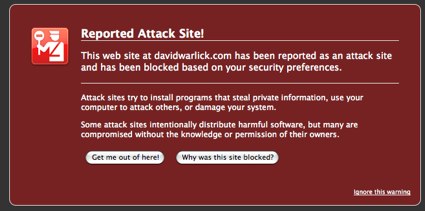 Here’s the problem. At some point, for some reason, Google detected malware on a blog page, and stored that little tid bit of info way. This shouldn’t be a problem since it’s not found anything in the last several weeks. However, Firefox 3.0 has a new Malware security feature that, when you load a page, checkes Google to see any malware has been detected in the past 90 days. If it finds one, then it fashes the warning you see on the right.
Here’s the problem. At some point, for some reason, Google detected malware on a blog page, and stored that little tid bit of info way. This shouldn’t be a problem since it’s not found anything in the last several weeks. However, Firefox 3.0 has a new Malware security feature that, when you load a page, checkes Google to see any malware has been detected in the past 90 days. If it finds one, then it fashes the warning you see on the right.
Since there doesn’t seem to be a way to remove this reference from Google until the 90 days are up, I am trying to move 2? Worth to a new location, http://davidwarlick.com/2-cents/. For folks who are having no problems at all — users of browsers other than Firefox 3.0 — I’m going to add a redirect. So there shouldn’t be any disruption — I hope. This shouldn’t disrupt RSS feeds at all.
Anyway, getting back to the work.
Thanks for your patience.
After EduBloggerCon
 EduBloggerCon is over and NECC is all around us. Yesterday’s amazing talk-fest was a huge success, by my reckoning — and to no small degree, thanks to the work and skill of Steve Hargadon. To me, I had a sesne, from the very beginning, there this day was going to be valuable. Going into a talk-fest, an unconference — it can be a daunting thing. There is no reason to know what to expect or if it’s going to work. It depends on the group, and an atmosphere of respect for a community of people. To me, it was immediately obvious that this was going to work, we could depend on this day for enlightenment, even if hard answers would remain elusive. [Image from Ewan McIntosh ((McIntosh, Ewan. “Geek Sesh.” Edublogger’s Photostream. 28 June 2008. 30 Jun 2008
EduBloggerCon is over and NECC is all around us. Yesterday’s amazing talk-fest was a huge success, by my reckoning — and to no small degree, thanks to the work and skill of Steve Hargadon. To me, I had a sesne, from the very beginning, there this day was going to be valuable. Going into a talk-fest, an unconference — it can be a daunting thing. There is no reason to know what to expect or if it’s going to work. It depends on the group, and an atmosphere of respect for a community of people. To me, it was immediately obvious that this was going to work, we could depend on this day for enlightenment, even if hard answers would remain elusive. [Image from Ewan McIntosh ((McIntosh, Ewan. “Geek Sesh.” Edublogger’s Photostream. 28 June 2008. 30 Jun 2008
I thank Steve, out loud, for giving us this, through his leadership.
There was some discussion at the end of the day about the growth of EduBloggerCon. I’m not sure how many people actually attended, but more than 200 were expected — significantly more than last year. Can an EduBloggerCon continue to function if the numbers continue to increase. I would think that it can, as long as it adapts. Among the suggestions were smaller rooms, less heavy machinery in the vicinity (you had to be there), more sessions running simultaneously, assurance that sessions will be unconference in nature, and more recording of the sessions.
One thing that I noticed was that a few conversations seemed to emerge in almost every session that I participated in. Among them were attitudes of teachers, attitudes of administrators, ubiquity of the technology, and a few others. There was a wide range of sessions suggested, but I wonder — and I’m just wondering — if there might be a way of focusing in on these fundamental issues, within the schedule and layout.
A problem that keeps nagging at me is that I didn’t come away with any hard answers. It’s probably because there aren’t any answers yet, and hard answers may not even be the point of an EduBloggerCon. But, I wonder if we might start next year’s event with a set of questions, and then ask attendees, after EduBloggerCon 2009, to collaborate in answering those questions from what they’ve learned from the conversations.
Finally, there was a long conversation at the end, about the appropriateness of Pearson’s recording a large part of the event. Personally, it didn’t bother me. We’re all making a living. But I had an interesting conversation on my way back to the hotel with John Costella (or was it Bob Carlton?), of WeAreTeachers, who has attended BloggerCons and BarCamps in the San Francisco area. He said that the ideas of commercialization was a staple conversation among these gatherings. We concluded that the attitudes and free-spirit thinking that makes a BloggerCon work, will predictably lead to conversations about the place of commerce.
Live Blogging EduBloggerCon
Where’s the Line
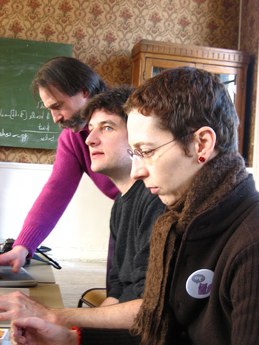 There’s a famous story about a student who, when assigned to write a report about a topic, started his report as a Wikipedia article. Then, over the following days, he watched while Wikipedia editors fleshed out his article, until, on the due date, he copied the text from the online encyclopedia,pasted it into his word processor and confidently turned it in. [Image ((Duhem-Verdière, Romy. “SPIP Coding Party.” Romytetue’s Photostream. 4 Mar 2006. 28 Jun 2008
There’s a famous story about a student who, when assigned to write a report about a topic, started his report as a Wikipedia article. Then, over the following days, he watched while Wikipedia editors fleshed out his article, until, on the due date, he copied the text from the online encyclopedia,pasted it into his word processor and confidently turned it in. [Image ((Duhem-Verdière, Romy. “SPIP Coding Party.” Romytetue’s Photostream. 4 Mar 2006. 28 Jun 2008
He got caught! But in listening to the story we either respond, “Oh! That’s dreadful!” or “Woe, that’s resourceful!” I talk about this in my video games presentation, that we really need more than one word for cheating, that some of the cheating that gammers engage in is actually quite resourceful, figuring out how to accomplish the goals by changing the rules.
We don’t do this in real life?
Anyway, this brings me to something I read this morning in Slashdot, a quote from an anonymous reader…
“Students studying computing in the UK and US are outsourcing their university coursework to graduates in India and Romania. Work is being contracted out for as little as ?5 on contract coding websites usually used by businesses. Students are outsourcing everything from simple coursework to full blown final year dissertations. It’s causing a major headache for lecturers who say it is almost impossible to detect.”
Clearly, this is cheating, taking credit for someone elses work. I’m wondering though, Where is the line? At what point do we forgive, or even encourage resourceful and inventive shortcutting, and at what point does it become … well, cheating?
Interstingly, if those students graduate and get their jobs, much of their work will be outsourced to India or Romania.
Words of NECC
I’ve been in San Antonio for almost a two hours now, mostly walking out to stock up on diet pepsis for my room, and watching CNN (pretty rare for me). In a few minutes, I’ll go out to a place called Boudros’ for dinner with a bunch of folks — don’t recall who — hope I’ll recognize them.
Anyway, while paying half of my attention on the news, and a quarter of it on the clock, I’ve been doing some searches of the NECC program for a few key words that occurred to me. Here is a listing of those words and the number of conference sessions or other events that included them. They are not listed in any particular order, just as I thought of them.
| Blog | 27 | 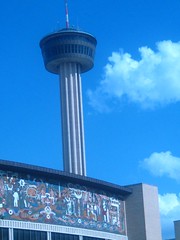 |
| Wiki | 35 | |
| wikipedia | 1 | |
| Podcast | 39 | |
| game | 38 | |
| web 2.0 | 46 | |
| Second Life | 10 | |
| open source | 19 | |
| visualization | 6 | |
| computational | 3 | |
| 21st century skills | 4 | |
| literacy | 42 | |
| social network | 13 | |
| social | 40 | |
| moodle | 17 | |
| flat | 5 | |
| creativ | 31 | |
| ebook | 2 | |
| muve | 3 | |
| nets?s | 11 |
I also found the PDF of the final entire program and ran the session through TagCrowd. Here are the 75 most used words in the sessions, in a tag cloud.
<!– #htmltagcloud{ font-family:’lucida grande’,trebuchet,’trebuchet ms’,verdana,arial,helvetica,sans-serif; line-height:2.4em; word-spacing:normal; letter-spacing:normal; text-decoration:none; text-transform:none; text-align:justify; text-indent:0ex; background-color:#fff; margin:1em 1em 0em 1em; border:2px dotted #ddd; padding:2em}#htmltagcloud a:link{text-decoration:none}#htmltagcloud a:visited{text-decoration:none}#htmltagcloud a:hover{text-decoration:none;color:white;background-color:#05f}#htmltagcloud a:active{text-decoration:none;color:white;background-color:#03d}span.tagcloud0{font-size:1.0em;padding:0em;color:#ACC1F3;z-index:10;position:relative}span.tagcloud0 a{text-decoration:none; color:#ACC1F3}span.tagcloud1{font-size:1.4em;padding:0em;color:#ACC1F3;z-index:9;position:relative}span.tagcloud1 a{text-decoration:none;color:#ACC1F3}span.tagcloud2{font-size:1.8em;padding:0em;color:#86A0DC;z-index:8;position:relative}span.tagcloud2 a{text-decoration:none;color:#86A0DC}span.tagcloud3{font-size:2.2em;padding:0em;color:#86A0DC;z-index:7;position:relative}span.tagcloud3 a{text-decoration:none;color:#86A0DC}span.tagcloud4{font-size:2.6em;padding:0em;color:#607EC5;z-index:6;position:relative}span.tagcloud4 a{text-decoration:none;color:#607EC5}span.tagcloud5{font-size:3.0em;padding:0em;color:#607EC5;z-index:5;position:relative}span.tagcloud5 a{text-decoration:none;color:#607EC5}span.tagcloud6{font-size:3.3em;padding:0em;color:#4C6DB9;z-index:4;position:relative}span.tagcloud6 a{text-decoration:none;color:#4C6DB9}span.tagcloud7{font-size:3.6em;padding:0em;color:#395CAE;z-index:3;position:relative}span.tagcloud7 a{text-decoration:none;color:#395CAE}span.tagcloud8{font-size:3.9em;padding:0em;color:#264CA2;z-index:2;position:relative}span.tagcloud8 a{text-decoration:none;color:#264CA2}span.tagcloud9{font-size:4.2em;padding:0em;color:#133B97;z-index:1;position:relative}span.tagcloud9 a{text-decoration:none;color:#133B97}span.tagcloud10{font-size:4.5em;padding:0em;color:#002A8B;z-index:0;position:relative}span.tagcloud10 a{text-decoration:none;color:#002A8B}span.freq{font-size:10pt !important;color:#bbb}#credit{text-align:center; font-size:0.7em; color:#333; margin-bottom:0.6em; font-family:’lucida grande’,trebuchet,’trebuchet ms’,verdana,arial,helvetica,sans-serif;}#credit a:link{color:#777; text-decoration:none;}#credit a:visited{color:#777; text-decoration:none;}#credit a:hover{text-decoration:none; color:white; background-color:#05f;}#credit a:active{text-decoration:underline;}// –>
Before Striking Out for NECC
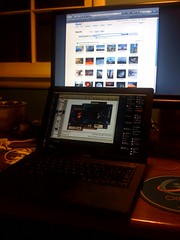 It’s not quite 6:00 AM EST, and I’ve been up for a couple of hours, worrying over one of the presentations I’ll be doing at NECC. I’m not nearly as busy with presentations this year as last, and won’t know until tomorrow if either of the EduBloggerCon sessions I suggested will fly.
It’s not quite 6:00 AM EST, and I’ve been up for a couple of hours, worrying over one of the presentations I’ll be doing at NECC. I’m not nearly as busy with presentations this year as last, and won’t know until tomorrow if either of the EduBloggerCon sessions I suggested will fly.
The one session that has me working overtime will happen on Sunday at the SETDA Emerging Technologies Forum. I’ve been asked to present, along with David Thornburg, a ten minute presentation for state ed tech leaders, coinciding with the continuing development of their Class 20/20 Action Plan for Education. While David will compellingly promote the STEM subjects (Science, Technology, Engineering, & Mathematics), I am planning to promote the equal importance of the creative arts (Music, Art, Drama) for the very same reasons, not just for the sake of culture, but as a critical economic leaverage point. Then again, I may change my mind and do something entirely different.
One thing that I do know is that preparing for a ten minute presentation is a lot harder than preparing for an hour.
I just took a quick scan of the NECC page on Hitchhikr, and found that it was not sorting the blog postings. So I fixed that, and just to break the menotony of all of those pre-conference Second LifeTM events, I uploaded a picture of my computer, while it was helping me plan for that SEDTA session. I’m sure that the photos will start pouring in today. I also discovered that there are a lot of things, whose acronyms work out to be NECC, such as the Navy Expeditionary Combat Command. I blocked that one out of Hitchhikr.
Anyway, I think I’ll spend the final hour before hitting the road, trying to clean up my NECC planner! 😉
Disruptive Conditions
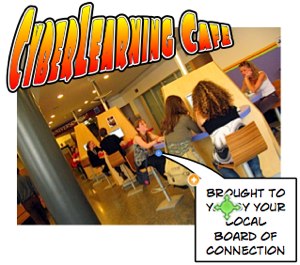 My old North Carolina friend, colleague, and reborn mountaineers, John Spagnolo, posted a comment on my NECC Ning Session Discussion. There is so much truth, packed into these few words, that it hurts. [Image ((Falgas, Julien. “Le Cybercaf? d’Amiens 2007.” Julien Jalgas (JiF)’s Photostream. 6 Jun 2007. 26 Jun 2008 <http://flickr.com/photos/julien-falgas/533554705/>. ))]
My old North Carolina friend, colleague, and reborn mountaineers, John Spagnolo, posted a comment on my NECC Ning Session Discussion. There is so much truth, packed into these few words, that it hurts. [Image ((Falgas, Julien. “Le Cybercaf? d’Amiens 2007.” Julien Jalgas (JiF)’s Photostream. 6 Jun 2007. 26 Jun 2008 <http://flickr.com/photos/julien-falgas/533554705/>. ))]
Our Students ? Our Worlds – NECC 2008:
The conditions brought about by the cognitive dissonance that students feel creates a surrealistic, unproductive and disengaged daytime experience at school, divorced and fundamentally unrelated to the @home realities of their entertainment channels, culture and social networks.
They know better ways to learn and communicate. They are skilled with the digital networking tools that can connect them to an emerging culture with world flattening literacy. I imagine that some of the best and brightest students feel sorry and unable to connect with the trapped and cynical late technology adopters in educational roles that get easily mired in the muck and backwater of an inherently unreliable, oppressive day old school infrastructure and technology.
The subversion necessary to stay meaningfully connected by day to a personal ?digital softspace? in a public education institution, separates those ?googling thumb drivers?, networked courageous apprentice educators and younger (in spirit) teachers from the administrators and those making us secure and walled off from all dangers in the emerging webagora. Knowing better while we muddle forward is making the old ways of teaching and learning uncomfortable and ineffective while subverting the new ways of connecting (and connecting to) knowledge and to each other.
Thanks, John, and hope to see you in San Antonio!
Infecting the School with Creative Arts
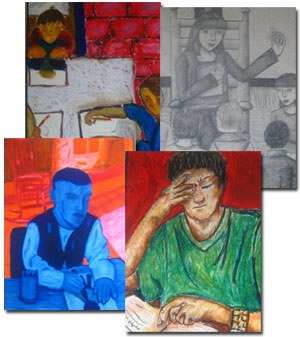 I had an interesting day yesterday in Spotsylvania County that ending delightfully with a walk through the Fredericsburg Battle Ground park with Brenda. She’d ridden the train up in the afternoon. I did two presentations during the day for educators in the county — one on the new story of education in the 21st century, and then an afternoon session with district art and music teachers. I have to admit that I went into that session with only a vague idea of what I wanted to accomplish.
I had an interesting day yesterday in Spotsylvania County that ending delightfully with a walk through the Fredericsburg Battle Ground park with Brenda. She’d ridden the train up in the afternoon. I did two presentations during the day for educators in the county — one on the new story of education in the 21st century, and then an afternoon session with district art and music teachers. I have to admit that I went into that session with only a vague idea of what I wanted to accomplish.
There is a growing sense of the importance of creativity and, by association, music, art, drama, etc. However, I think that it would be a mistake to merely bask in the glow of seeing creativity splashed across the goals of various state and national standards. I think that it is critical that creative arts teachers, and all teachers, come to understand the conditions that have brought about recent interest in creativity as a basic skill, and adapt what they do to address and reflect the conditions — reinventing themselves.
I presented some ideas about how our evolving information landscape has changed what we should consider to be basic literacy skills. I also shared and discussed a list of fundamental qualities of our students’ nearly native information activities. The list was generated by a group of teachers in Texas who have worked in a 1:1 environment since 1997. Interestingly, that list remarkable paralleled a list of leverage points shared with the group during a morning meeting.
The end of the session was spent in general discussion, though I found the group to be somewhat more shy than I would have expected of art and music teachers. It was the afternoon, though, and they’d been in meetings all morning.
One of the most interesting comments that I heard was how student communities tended to casually form around the arts. This was certainly the case with my son’s high school experience with music and band. Related, I think, to this sense of community was the problem of losing so many students from art, music, and drama, when they reached high school. Many of the students who excelled and enjoyed the arts, found, when they reached high school, that all of their school day periods would be required to take the core courses they would need to get into college.
It occurred to the conversation, that community might serve to continue a tie between students and the arts, and the arts and the school, regardless of class courses and class walls. Essentially, how could you make the arts and arts instruction happen outside the walls of the art classroom and the noise-suppressing walls of the band room? How could we covertly cultivate those communities, independent of classes and facilitate creative arts instruction through those communities?
How might we inject the creative arts into the culture of the school and the greater community, infecting them with creative expression?

